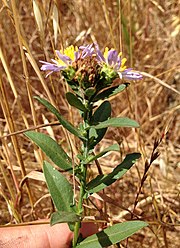| Symphyotrichum chilense | |
|---|---|

| |
| Conservation status | |
 Secure (NatureServe) | |
| Scientific classification | |
| Kingdom: | Plantae |
| Clade: | Tracheophytes |
| Clade: | Angiosperms |
| Clade: | Eudicots |
| Clade: | Asterids |
| Order: | Asterales |
| Family: | Asteraceae |
| Tribe: | Astereae |
| Subtribe: | Symphyotrichinae |
| Genus: | Symphyotrichum |
| Subgenus: | Symphyotrichum subg. Symphyotrichum |
| Section: | Symphyotrichum sect. Occidentales |
| Species: | S. chilense |
| Binomial name | |
| Symphyotrichum chilense (Nees) G.L.Nesom | |

| |
| Native distribution | |
| Synonyms | |
|
Basionym
| |
Symphyotrichum chilense (formerly Aster chilensis) is a species of flowering plant in the family Asteraceae known by the common names Pacific aster and common California aster. It is native to the west coast of North America from British Columbia to Southern California and the Channel Islands. It grows in many habitats, especially along the coast and in the coastal mountain ranges. Despite its scientific name, it does not occur in Chile. Pacific aster blooms from June to October with violet ray florets surrounding yellow disk florets.
Description

Symphyotrichum chilense is a rhizomatous, perennial, herbaceous plant growing to heights between 40 and 120 centimeters (1+1⁄4 and 4 feet). The sparsely hairy leaves are narrowly oval-shaped, pointed, and sometimes finely serrated along the edges. The inflorescence holds flower heads that open June–October with centers of 35–60+ yellow disk florets surrounded by 15–40 narrow violet ray florets. The fruit is a seed, specifically a rounded, hairy cypsela with pappi.
Distribution and habitat
Pacific aster is native to west coast provinces and states of North America in British Columbia; California, including Southern California and the Channel Islands; Oregon; and, Washington. Despite its scientific name, it does not occur in Chile.
It can be found in coastal habitats including salt marshes, ocean dunes and banks, grasslands, and coniferous forests, at elevations of 0–500 meters (0–1,600 feet).
Conservation
Citations
References
- Allen, G.A. (2012). "Symphyotrichum chilense". In Jepson Flora Project (ed.). Jepson eFlora. The Jepson Herbarium, University of California, Berkeley. Retrieved 25 July 2021.
- Brouillet, L.; Semple, J.C.; Allen, G.A.; Chambers, K.L.; Sundberg, S.D. (2006). "Symphyotrichum chilense". In Flora of North America Editorial Committee (ed.). Flora of North America North of Mexico (FNA). Vol. 20. New York and Oxford: Oxford University Press. Retrieved 25 July 2021 – via eFloras.
- NatureServe (2 July 2021). "Symphyotrichum chilense Pacific American-aster". NatureServe Explorer (explorer.natureserve.org). Arlington, Virginia: NatureServe. Retrieved 10 July 2021.
- POWO (2021). "Symphyotrichum chilense (Nees) G.L.Nesom". Plants of the World Online. Royal Botanic Gardens, Kew. Retrieved 25 July 2021.
External links
- Symphyotrichum chilense in the CalPhotos photo database, University of California, Berkeley
| Taxon identifiers | |
|---|---|
| Symphyotrichum chilense |
|
| Aster chilensis | |
- NatureServe secure species
- Symphyotrichum
- Flora of the West Coast of the United States
- Flora of British Columbia
- Flora of California
- Flora of Oregon
- Flora of the Klamath Mountains
- Natural history of the California chaparral and woodlands
- Natural history of the California Coast Ranges
- Natural history of the Channel Islands of California
- Natural history of the San Francisco Bay Area
- Natural history of the Santa Monica Mountains
- Natural history of the Transverse Ranges
- Plants described in 1832
- Taxa named by Christian Gottfried Daniel Nees von Esenbeck